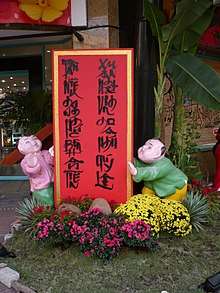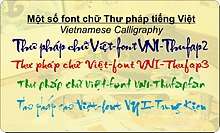Vietnamese calligraphy
Vietnamese calligraphy (Vietnamese Quốc ngữ: thư pháp Việt Nam, Hán Nôm: 書法越南) relates to the calligraphic traditions of Vietnam. It includes calligraphic works using a variety of scripts, including Chinese characters, Chữ nôm, and the Latin-based Quốc ngữ. Historically, calligraphers used the former two scripts. However, due to the adoption of the Latin-based Quốc ngữ, modern Vietnamese calligraphy also uses Roman script.


Traditional Vietnamese calligraphy is strongly affected by that of China. As part of the East Asian cultural sphere, Classical Chinese was often used as the written medium of communication, and as a result, Vietnamese calligraphy also follows Chinese calligraphy’s standard and uses Han script (Chinese language) in many of its writings. For example, during the Lý dynasty, its style was very similar to China’s Tang dynasty (618-907). During the Trần dynasty, it was influenced strongly by China’s Song (960-1279) and Yuan (1271-1368) dynasties.[1]
Nonetheless, over time, Vietnam developed its own styles of calligraphy for writing both Classical Chinese and Chữ nôm. In the later Lê dynasty, Vietnam developed a unique style of calligraphy called "Nam tự" (南字, lit. ‘southern script’) by Phạm Đình Hổ (範廷琥) in his book Vũ Trung Tùy Bút (雨中隨筆).[2] It was first used in bureaucracy only but later became popular for all writing purposes. It was also called "Lệnh Thư" (令書, lit. ‘script for decrees’) in Việt Sử Toát Yếu (越史撮要) because of its initial bureaucratic characteristic.[3]
In modern times, calligraphy has been done frequently in the Latin-based Vietnamese alphabet Quốc Ngữ script, as Chữ Nôm and Chinese characters have largely fallen out of use.[4] Quốc Ngữ calligraphy gained popularity during the New Poetry and Free Poetry Movements, due to the increasing popularity of using the Vietnamese vernacular, as well as influence from French literature. Modern Vietnamese calligraphy is undoubtedly influenced by modern Latin cursive but is written using the calligraphy brush, rather than quill or reed pens as is done in Western calligraphy. Much as Chinese calligraphy is used to write poems, festive banners, signage, and so on, Vietnamese calligraphy can also serve the same purpose today.



.jpg) "Boat People" (Thuyền nhân)
"Boat People" (Thuyền nhân)

See also
| Wikimedia Commons has media related to Vietnamese calligraphy. |
References
- The Lunar New Year banner reads: Tân niên hạnh phúc bình an tiến, xuân nhật vinh hoa phú quý lai.
- "New book tells story of VN calligraphy". Vietnam News. Retrieved March 19, 2018.
- Vũ Trung Tùy Bút (in Vietnamese).
- Việt Sử Toát Yếu (in Vietnamese).
- "Vietnamese neglect Han-Nom heritage". Viet Nam News. February 14, 2012. Retrieved December 18, 2013.